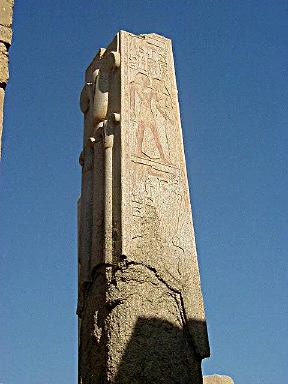Preliminary Note: From ancient times to the present, visitors to Egypt have left tangible evidence of their presence. There seems to be something in the human makeup that demands planting our names and -- as the ancient Egyptians believed -- our immortal presence on historic monuments. The pharaohs were prolific at it. Ramesses II, in particular, had his name (cartouche) carved on temples and statues all over Egypt (a goodly number, but not all, of which were his own).
The two 19th-century examples shown below, carefully and almost professionally carved, are especially interesting but for different reasons.
John Gordon carved his name at several pharaonic temples. In this case he set himself immediately beneath a cartouche of Ramesses II. Now that's chutzpah for you! (He didn't know what he was doing, but no matter.) Champollion, Jean-François Champollion, who first deciphered Egyptian hieroglyps using the Rosetta Stone, definitely knew better; temptation obviously got the better of him.
| The Karnak temple (Ipet-Issut -- "the most sacred of places" -- in ancient times) is not one temple; it is many. At the heart is the temple of Amun-Re with its hypostyle hall of 134 pillars, the tallest of which tower 78 feet above the tourists, who can but marvel at the glory it must have been when completed by the workmen of Ramesses II in the 13th century BCE.
|
The hypostyle hall was begun by Ramesses I, founder of the 19th Dynasty, but it was completed and decorated by his son Seti I and his grandson Ramesses II. The interior of the temple is devoted to religious themes (the god Amun is the figure in the photograph, above right, with the tall plumed headdress). The exterior, which is now inside because of the construction of later pharaohs, holds scenes of military victories by Seti I and Ramesses II. Those latter would have been visible to "ordinary" people, while the columns and the shrine containing the statue of Amun himself, were reserved for the king and the highest in the priestly ranks.
However central and important Amun certainly was, the Karnak complex also contained temples dedicated to Amun's consort, Mut, and their son, Khons -- the "Theban Triad." (Each of the major Egyptian cult temples was devoted to a triad of gods, usually a father, mother, and son. Interesting question: why not "trinity"?)
Amun was a relatively minor creator god localized at Thebes until the reunification of Egypt following the First Intermediate Period (2150-2040 BCE; Dynasties 7-10) by the Theban kings of the Middle Kingdom (2040-1640 BCE; Dynasties 11-13). Amun -- a name that connotes the "hiddenness of divinity" -- was merged with the Old Kingdom sun god of Heliopolis, Re. Thus Amun-Re became the "hidden radiance sustaining all life." [N.B. "Amun" may be spelled "Amen" or "Amon" and "Re" may be spelled "Ra." You pays you money and takes you choice.]
| | Hatshepsut at Karnak |
Tuthmosis III, Hatshepsut's step-son, nephew, and co-regent, became king in his own right upon her death. Toward the end of his more than 50-year reign (which included the years of Hatshepsut) Tuthmosis apparently decided that, for the sake of the direct continuity of the dynasty from Tuthmosis I through his father, Tuthmosis II, to himself, it would be advisable to eradicate the memory of Hatchepsut by erasing her cartouches and images from her monuments. Her obelisks were walled in to become part of Tuthmosis' own constructions and her figure was hacked out of Karnak's walls, as exemplified in the photograph above.
Still another of Hatshepsut's obelisks never made it to its intended site. Today it's called the "Unfinished Obeslik."
 |
Virtually the entire history of Pharaonic Egypt may be read in the ruins of Karnak, including that of pharaohs who were not Egyptian at all but Nubians, Greeks, or Romans. I keep having to remind myself that what I'm doing is a travel report, not a history text, so it's OK to jump around a lot. Actually, there's not much choice when it comes to Karnak because the "history" is all jumbled up there. Kings kept tearing down what their predecessors built and replacing it with their own cartouches and/or temples, etc.
The geography of the complex consists of a series of pylons (monumental gates), the outer ones of which are of more recent vintage than the inner. Thus the First Pylon, the most recent and through which today visitors enter Karnak, was probably begun by Taharqa (see next paragraph) and continued by Nectanebo I (380-362 BCE), the first king of the 30th Dynasty, but left unfinished. In fact, the mud brick ramp used in construction was left to melt back into the soil on its own, a process that, fortunately, is not yet complete.
In the First Court of the Amun temple stands the sole remaining column of the colonnade built by the 25th Dynasty pharoah Taharqa (690-664 BCE). Taharqa, one of the Nubian (Ethiopian) kings of the Third Intermediate Period, has the distinction of being mentioned in the Bible (2 Kings 19:9). His column, almost 70 feet tall, gives the visitor an initial feeling for the magnitude that is Karnak.
Another avenue of sphinxes led from Karnak to Luxor through which the barque of Amun was carried to Luxor for the Opet Festival. For that let us go to Luxor Temple, less than two miles south.